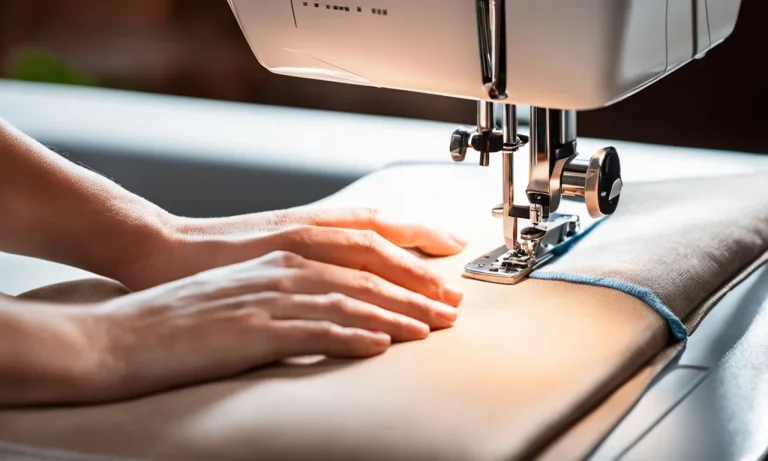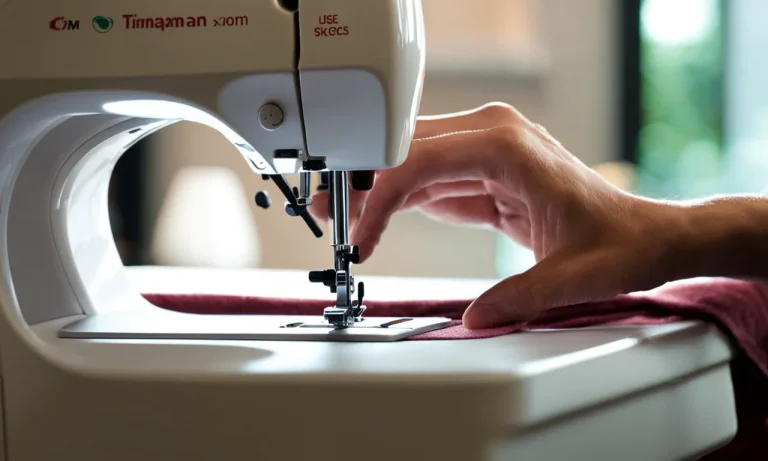Is 80% Cotton 20% Polyester Good? A Detailed Look
With so many fabric blends on the market, it can be tricky to know which ones are best. If you’re looking at an 80% cotton 20% polyester blend, you may be wondering – is this a good fabric? Let’s take a deeper dive.
If you’re short on time, here’s a quick answer: 80/20 cotton/polyester blends offer the breathability of cotton along with the durability and wrinkle-resistance of polyester, making them popular and versatile fabrics. But they may not be as soft as 100% cotton.
In this comprehensive guide, we’ll explore the pros and cons of 80/20 cotton/polyester fabrics. We’ll look at how the blend affects factors like feel, breathability, shrinkage, wrinkling, and durability. We’ll also discuss the best uses for 80/20 blends and provide tips for caring for this fabric.
What is an 80/20 Cotton/Polyester Blend?
An 80/20 cotton/polyester blend refers to a fabric composition that is made up of 80% cotton fibers and 20% polyester fibers. This blend is commonly used in the textile industry for various applications, including clothing, bedding, and upholstery.
The combination of these two materials offers a unique set of characteristics that make it a popular choice among manufacturers and consumers alike.
Breakdown of the blend
When it comes to understanding the composition of an 80/20 cotton/polyester blend, it’s important to know the properties of each material individually. Cotton is a natural fiber known for its softness, breathability, and ability to absorb moisture.
On the other hand, polyester is a synthetic fiber that is durable, wrinkle-resistant, and quick-drying.
By blending these two fibers together, manufacturers can create a fabric that combines the best of both worlds. The cotton component provides comfort and breathability, while the polyester component adds strength and durability.
This blend is often favored for its ability to offer the benefits of both natural and synthetic fibers.
How it differs from 100% cotton
While an 80/20 cotton/polyester blend shares some similarities with 100% cotton, there are a few key differences to consider. One notable difference is the level of shrinkage. Cotton has a tendency to shrink when washed and dried, whereas polyester is more resistant to shrinkage.
As a result, fabrics made from an 80/20 blend may experience less shrinkage compared to those made from 100% cotton.
Another difference is the level of wrinkle resistance. Polyester fibers have a natural resistance to wrinkles, which means that fabrics containing polyester tend to be less prone to wrinkling compared to pure cotton fabrics.
This can be advantageous for those who prefer low-maintenance clothing and bedding options.
Additionally, the blend offers enhanced durability. Polyester fibers are known for their strength and resistance to wear and tear, making fabrics made from an 80/20 blend more durable than those made from 100% cotton. This can be particularly beneficial for items that undergo frequent use or washing.
Pros of 80/20 Cotton/Polyester
Good breathability
One of the pros of choosing a fabric blend of 80% cotton and 20% polyester is its good breathability. Cotton is a natural fiber that allows air to circulate easily, keeping you cool and comfortable. Polyester, on the other hand, is a synthetic fiber that helps to wick away moisture, keeping you dry.
The combination of these two fibers in an 80/20 blend ensures that the fabric remains breathable, making it suitable for various weather conditions.
Durable and wrinkle-resistant
Another advantage of 80/20 cotton/polyester fabric is its durability and wrinkle-resistance. Cotton is known for its strength and ability to withstand regular wear and tear, while polyester adds durability and helps the fabric retain its shape.
This blend is less likely to shrink or stretch compared to fabrics made solely of cotton. Additionally, the polyester content reduces the fabric’s tendency to wrinkle, making it easier to maintain and requiring less ironing.
Versatile and affordable
The 80/20 cotton/polyester blend is highly versatile, making it suitable for a wide range of applications. This fabric is commonly used in the production of t-shirts, sweatshirts, hoodies, and other casual wear.
It offers a comfortable and relaxed fit, making it a popular choice for everyday clothing. In addition to its versatility, the 80/20 blend is also more affordable compared to fabrics made entirely of cotton. This makes it a cost-effective option for both manufacturers and consumers.
Cons of 80/20 Cotton/Polyester
Not as soft as 100% cotton
One of the drawbacks of 80/20 cotton/polyester blend fabric is that it is not as soft as 100% cotton. While cotton is known for its natural softness and comfort, the addition of polyester fibers can make the fabric slightly rougher to the touch.
This is because polyester is a synthetic fiber that doesn’t have the same natural softness as cotton. So, if you prioritize softness in your clothing, you may find that a 100% cotton fabric would be a better choice for you.
Can get overly warm
Another downside of 80/20 cotton/polyester fabric is that it can get overly warm, especially in hot and humid climates. Polyester fibers are known to trap heat, which can make you feel uncomfortable and sweaty.
While cotton is breathable and allows air to circulate, the addition of polyester in the blend can hinder this natural breathability. If you tend to overheat easily or live in a hot climate, you might want to consider opting for a fabric that is more lightweight and breathable.
May shrink slightly
One potential issue with 80/20 cotton/polyester fabric is that it may shrink slightly after washing and drying. While both cotton and polyester are prone to shrinkage to some extent, a blend of the two can increase the chances of shrinkage.
It is important to follow the care instructions provided by the manufacturer to minimize the risk of shrinkage. However, if you prefer a fabric that is less likely to shrink, you may want to consider garments made from 100% cotton or other natural fibers.
Best Uses for 80/20 Cotton/Polyester
When it comes to choosing the right fabric blend for clothing, 80% cotton and 20% polyester is a popular choice. This particular blend offers a unique combination of comfort, durability, and affordability. Here are some of the best uses for 80/20 cotton/polyester:
Casual everyday wear
One of the great things about 80/20 cotton/polyester blend is its versatility. It is an excellent choice for casual everyday wear due to its softness, breathability, and ability to withstand frequent washing.
Whether you’re running errands or meeting friends for coffee, clothing made from this blend will keep you comfortable and looking stylish.
Many popular clothing brands offer a wide range of t-shirts, hoodies, and sweatshirts made from 80/20 cotton/polyester blend. These garments are known for their excellent fit, soft feel, and long-lasting quality.
Activewear
When it comes to activewear, 80/20 cotton/polyester blend is a fantastic choice. The cotton component provides comfort and breathability, while the polyester component adds durability and moisture-wicking properties.
This blend is perfect for activities that require a lot of movement and sweat, such as running, yoga, or gym workouts.
Many sports apparel brands utilize 80/20 cotton/polyester blend in their activewear collections. The moisture-wicking properties of this blend help keep you dry during intense workouts, while the cotton ensures a comfortable fit.
Work uniforms
Another great use for 80/20 cotton/polyester blend is in work uniforms. Whether you work in the healthcare industry, hospitality, or any other field that requires a uniform, clothing made from this blend offers the perfect combination of comfort and durability.
Work uniforms made from 80/20 cotton/polyester blend are known for their ability to withstand frequent washing and maintain their shape and color. They are also resistant to wrinkles, making them a practical choice for busy professionals.
Caring for 80/20 Cotton/Polyester
When it comes to caring for clothing made from an 80% cotton and 20% polyester blend, it’s important to follow the proper care instructions to ensure longevity and maintain the fabric’s quality. Here are some tips on how to care for your 80/20 cotton/polyester garments:
Washing
When washing your 80/20 cotton/polyester clothes, it’s best to use a gentle cycle with cold water. This helps prevent shrinkage and color fading. Avoid using harsh detergents or bleach, as they can damage the fabric. Instead, opt for a mild detergent that is specifically designed for delicate fabrics.
It’s also a good idea to turn your garments inside out before washing to minimize friction and protect any printed or embroidered designs.
If you’re dealing with stains, treat them as soon as possible. You can use a stain remover or a mixture of water and mild detergent to gently work on the stain before washing. Be sure to follow the instructions provided by the stain remover manufacturer.
Drying
When it comes to drying 80/20 cotton/polyester clothing, it’s best to air dry them whenever possible. This helps prevent shrinkage and maintains the fabric’s shape. If you do choose to use a dryer, make sure to select a low heat setting to avoid damaging the fabric.
Remove the clothes promptly once they are dry to prevent wrinkles from setting in.
It’s important to note that excessive heat can cause the polyester fibers to melt or shrink, so it’s always better to err on the side of caution and use lower heat settings.
Ironing
Ironing 80/20 cotton/polyester garments can be a bit tricky. Polyester fibers have a lower melting point compared to cotton, so it’s crucial to use a low to medium heat setting on your iron. Always test a small, inconspicuous area before ironing the entire garment.
If possible, it’s best to use a steamer instead of an iron to remove wrinkles from your 80/20 cotton/polyester clothing. Steamers are gentler on the fabric and can help eliminate wrinkles without the risk of damaging the fibers.
Remember, it’s always important to read and follow the care label instructions provided by the manufacturer. These instructions are tailored specifically to the fabric blend and will help you extend the life of your 80/20 cotton/polyester garments.
Conclusion
While it’s not suitable for all purposes, an 80/20 cotton/polyester blend offers a good combination of cotton’s breathability and polyester’s durability. This versatile, affordable fabric works well for casual wear, uniforms, activewear, and more.
Following the proper care methods will help your 80/20 clothing last. So if you’re looking for a fabric that’s easy to care for and can stand up to daily wear, an 80/20 cotton/polyester blend just might be your match.







